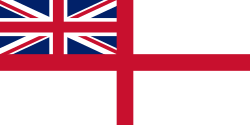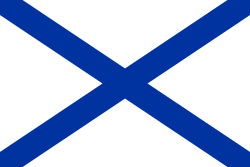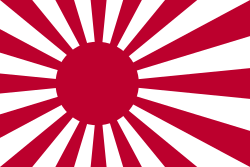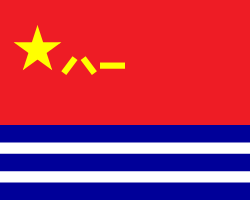Raketový torpédoborec

Raketový torpédoborec je torpédoborec, jehož hlavní výzbroj tvoří řízené střely. Zpravidla se jedná o moderní, komplexně vyzbrojené válečné lodě schopné vést bojovou činnost proti hladinovým, vzdušným i podvodním cílům. Standardní označení NATO pro tento typ plavidel je DDG.[1]
Třídy raketových torpédoborců
 Australské královské námořnictvo
Australské královské námořnictvo
 Britské královské námořnictvo
Britské královské námořnictvo
 Námořnictvo Čínské lidové osvobozenecké armády
Námořnictvo Čínské lidové osvobozenecké armády
- Torpédoborec typu 055 (jindy klasifikován jako křižník)
- Torpédoborec typu 052D
- Torpédoborec typu 052C
- Torpédoborec typu 052B
- Torpédoborec typu 052
- Torpédoborec typu 051C
- Torpédoborec typu 051B
- Torpédoborec typu 051
 Námořnictvo Čínské republiky
Námořnictvo Čínské republiky
 Francouzské námořnictvo
Francouzské námořnictvo
- Třída Horizon (ve Francii fregata, podle klasifikace NATO torpédoborec)
 Indické námořnictvo
Indické námořnictvo
 Italské námořnictvo
Italské námořnictvo
 Japonské námořní síly sebeobrany
Japonské námořní síly sebeobrany
 Námořnictvo Korejské republiky
Námořnictvo Korejské republiky
 Námořnictvo Ruské federace
Námořnictvo Ruské federace
- Třída Sovremennyj
- Třída Udaloj
 Námořnictvo Spojených států amerických
Námořnictvo Spojených států amerických
- Třída Arleigh Burke
- Třída Zumwalt
- Třída DDG(X) (plánované)
 Španělské námořnictvo
Španělské námořnictvo
- Třída Álvaro de Bazán (ve Španělsku fregata, podle klasifikace NATO torpédoborec)
Odkazy
Reference
- ↑ Classification of Naval Ships and Craft [online]. Washington, D.C.: Department of the Navy, 2006-11-21 [cit. 2022-11-24]. Dostupné v archivu pořízeném z originálu dne 2022-11-24. (anglicky)
Média použitá na této stránce
The ensign consists of the Indian national flag on the upper canton, a blue octagon encasing the national emblem atop an anchor to depict steadfastness, superimposed on a shield with the Navy’s motto “Śaṁ No Varunaḥ” (a Vedic mantra invoking the god of seas to be auspicious) in Devanagari. The octagon represents the eight directions and has been included as a symbol of the Navy’s “multidirectional reach and multidimensional operational capability”. The golden borders of the octagon have been inspired by the seal of Maratha Emperor Chhatrapati Shivaji Maharaj.
Při zobrazení tohoto souboru lze snadno přidat orámování
Naval jack of the Republic of Korea, adopted in 1955
Marine Nationale and French merchant ensign. Used from 1794 to 1814/1815, and from 1848 to present.
Notice that its proportions differ from those of the French civil flag. (ensign : 30:33:37, civil : 1/3,1/3,1/3)
Při zobrazení tohoto souboru lze snadno přidat orámování
Autor: David Newton, uploader was Denelson83, Licence: CC BY-SA 3.0
Vlajka Japonskej cisárskej armády
The Flag of the United States Navy, as defined in Executive Order 10812 of April 24, 1959. The design is described there as:
The flag for the United States Navy is 4 feet 4 inches hoist by 5 feet 6 inches fly, of dark blue material, with yellow fringe, 2½ inches wide. In the center of the flag is a device 3 feet and 1 inch overall consisting of the inner pictorial portion of the seal of the Department of the Navy (with the exception that a continuation of the sea has been substituted for the land area), in its proper colors within a circular yellow rope edging, all 2 feet 6 inches in diameter above a yellow scroll inscribed "UNITED STATES NAVY" in dark blue letters.
The U.S. Navy flag is used for display purposes at ceremonies, parades, and other public functions where the U.S. Navy has an official presence, usually being carried by an honor guard on ceremonial occasions. It is not used for outdoor, fixed (permanent) purposes, and is not flown on Navy ships. Versions without fringe and different dimensions seem to be common, though it appears they are not technically the official U.S. Navy flag, as the executive order has not been amended.
Prior to 1959, the Navy Infantry Battalion flag was used to represent the U.S. Navy.
For more information, see the Navy's flag history page, SeaFlags, Flags of the World, U.S. Navy document NTP 13(B) [1], section 1710, and Navy regulation OPNAVINST 10520.1 (which replaced a similar SECNAVINST 10520.2D regulation from 1974).A Standard Missile-3 is launched from the Japanese Aegis Destroyer JS Kongo (DDG 173) enroute to an intercept of a target missile launched from the Pacific Missile Range Facility. The successful intercept occurred during Japan's first Aegis missile test.












